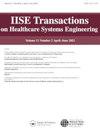When Is It Worth It for Two Hospital Network Pharmacies to Operate as an Integrated Inventory System in the Presence of Supply Chain Disruptions?
IF 1.5
Q3 HEALTH CARE SCIENCES & SERVICES
IISE Transactions on Healthcare Systems Engineering
Pub Date : 2023-10-03
DOI:10.1080/24725579.2023.2264867
引用次数: 0
Abstract
AbstractHospital pharmacies stock perishable drugs that experience supply chain disruptions. A potential solution to alleviate the negative effects of shortages caused by these disruptions is lateral transshipments (i.e., sharing of inventory; integrated inventory system) between hospital network pharmacies with independent suppliers. However, it is unclear when it is beneficial to operate as an integrated inventory system. We create a modeling framework to solve for the integrated inventory policies in a two-hospital network pharmacy inventory system. We find that (i) to benefit from an integrated inventory system, the lateral transshipment cost must be sufficiently less than the shortage cost; sufficient largely influenced by the duration of and time between supply chain disruptions. We find (ii) hospital network pharmacies need to consider the duration of and time between supply chain disruptions when selecting a hospital network pharmacy with which to share inventory. The integrated inventory policies demonstrate that perishable inventory systems with supply chain disruptions may benefit from sharing inventory. In our hospital network pharmacy setting, this contradicts the strict regulations in current practice that generally prohibit hospital network pharmacies from sharing drugs or make it very difficult for hospital network pharmacies to stay compliant when sharing drugs outside of their network.KEYWORDS: supply chain managementinventory managementhospital pharmacyhealthcareDisclaimerAs a service to authors and researchers we are providing this version of an accepted manuscript (AM). Copyediting, typesetting, and review of the resulting proofs will be undertaken on this manuscript before final publication of the Version of Record (VoR). During production and pre-press, errors may be discovered which could affect the content, and all legal disclaimers that apply to the journal relate to these versions also. FundingThe author(s) reported there is no funding associated with the work featured in this article.在存在供应链中断的情况下,两家医院网络药房何时值得作为一个集成库存系统运行?
医院药房库存易腐烂的药品,经历供应链中断。缓解这些中断造成的短缺负面影响的一个潜在解决办法是横向转运(即共享库存;医院网络药房与独立供应商之间的整合库存系统。然而,目前尚不清楚何时作为一个综合盘存系统运作是有益的。本文建立了一个模型框架来解决两医院网络药房库存系统的集成库存策略问题。我们发现:(1)为了从综合库存系统中获益,横向转运成本必须充分小于缺货成本;充足性在很大程度上受供应链中断的持续时间和间隔时间的影响。我们发现(ii)医院网络药房在选择与之共享库存的医院网络药房时,需要考虑供应链中断的持续时间和时间间隔。综合库存政策表明,供应链中断的易腐库存系统可能受益于共享库存。在我国医院网络药房设置中,这与目前实践中严格的规定相矛盾,现行规定一般禁止医院网络药房共享药品,或者使医院网络药房在网络外共享药品时很难保持合规。关键词:供应链管理库存管理医院药学医疗免责声明作为对作者和研究人员的服务,我们提供此版本的已接受稿件(AM)。在最终出版版本记录(VoR)之前,将对该手稿进行编辑、排版和审查。在制作和印前,可能会发现可能影响内容的错误,所有适用于期刊的法律免责声明也与这些版本有关。作者报告说,没有与本文所述工作相关的资金。
本文章由计算机程序翻译,如有差异,请以英文原文为准。
求助全文
约1分钟内获得全文
求助全文
来源期刊

IISE Transactions on Healthcare Systems Engineering
Social Sciences-Safety Research
CiteScore
3.10
自引率
0.00%
发文量
19
期刊介绍:
IISE Transactions on Healthcare Systems Engineering aims to foster the healthcare systems community by publishing high quality papers that have a strong methodological focus and direct applicability to healthcare systems. Published quarterly, the journal supports research that explores: · Healthcare Operations Management · Medical Decision Making · Socio-Technical Systems Analysis related to healthcare · Quality Engineering · Healthcare Informatics · Healthcare Policy We are looking forward to accepting submissions that document the development and use of industrial and systems engineering tools and techniques including: · Healthcare operations research · Healthcare statistics · Healthcare information systems · Healthcare work measurement · Human factors/ergonomics applied to healthcare systems Research that explores the integration of these tools and techniques with those from other engineering and medical disciplines are also featured. We encourage the submission of clinical notes, or practice notes, to show the impact of contributions that will be published. We also encourage authors to collect an impact statement from their clinical partners to show the impact of research in the clinical practices.
 求助内容:
求助内容: 应助结果提醒方式:
应助结果提醒方式:


